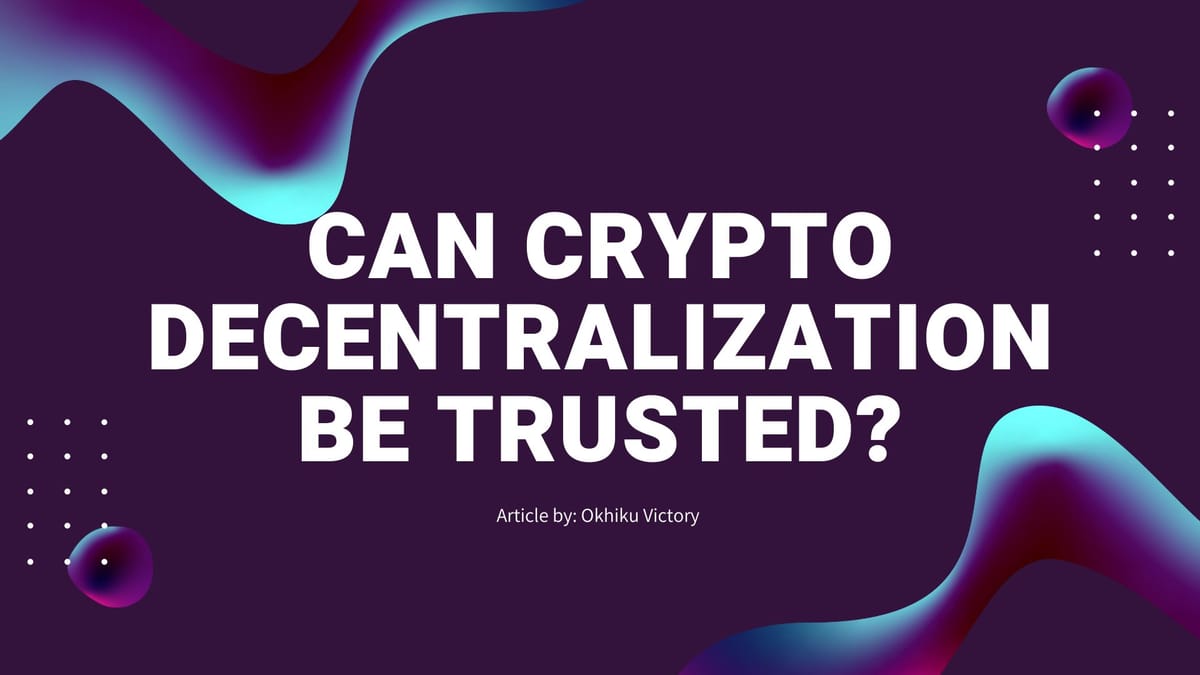Can Crypto Decentralization be Trusted? Risks and Realities in 2025

Introduction
The allure of decentralization has been a cornerstone of the cryptocurrency revolution, promising a financial system free from centralized control, intermediaries, and single points of failure. From Bitcoin’s inception to the rise of Layer-1 blockchains like Solana and Ethereum, the vision of a trustless, transparent ecosystem has captivated millions. Yet, as we navigate 2025, the question looms: Can you truly trust decentralization?
While decentralized platforms, such as decentralized exchanges (DEXs) and Layer-2 scaling solutions, offer unprecedented autonomy, they come with risks—smart contract vulnerabilities, liquidity issues, and user errors—that challenge their reliability.
This article delves into the realities of decentralization, exploring its risks and rewards through four critical lenses: security, scalability, user experience, and regulatory challenges. By examining real-world examples and actionable insights, we aim to uncover whether decentralization delivers on its promise or if it’s a double-edged sword for crypto users.
Security in Decentralized Systems: A Double-Edged Sword
Decentralized systems, built on Layer-1 blockchains like Solana and Ethereum, aim to eliminate reliance on centralized custodians. However, their security is not infallible. Smart contracts, governance protocols, and user practices introduce vulnerabilities that can lead to significant losses.
Smart Contract Vulnerabilities
Smart contracts are the backbone of decentralized applications (dApps), automating transactions on platforms like Solana and Polygon. These self-executing codes promise trustless operations but are prone to bugs and exploits. A single flaw can drain millions in misassets, undermining trust in decentralization.
Example: In 2023, a Solana-based DEX, Mango Markets, suffered a $100 million exploit due to a smart contract vulnerability that allowed attackers to manipulate asset prices. Similarly, Ethereum’s Layer-2 platform Optimism faced a $20 million hack when a governance contract was misconfigured. These incidents highlight that even robust Layer-1 and Layer-2 networks are not immune to coding errors. Tools like formal verification and audits by firms like CertiK can mitigate risks, but they’re not foolproof. Users must research dApp audit histories and avoid unvetted protocols to protect their misassets
Private Key Management Risk
Decentralization places the burden of security on users, who must safeguard their private keys—cryptographic codes granting access to crypto wallets. Unlike centralized exchanges, where password resets are possible, losing a private key in a decentralized system means permanent loss of funds. Phishing attacks and user errors further exacerbate this risk.
Examples: In 2024, a Solana user lost $500,000 in misassets after falling for a phishing scam that tricked them into revealing their private key via a fake wallet app. Another case involved an Ethereum Layer-2 user who misplaced their seed phrase, rendering $200,000 in tokens inaccessible. Hardware wallets like Ledger and multi-signature setups can enhance security, but they require technical know-how. These examples underscore the need for user education and robust security practices in decentralized ecosystems.
Scalability Challenges: Balancing Speed and Decentralization
Scalability remains a critical hurdle for decentralized networks. Layer-1 blockchains like Solana boast high throughput, but trade-offs in decentralization or security often arise. Layer-2 solutions, such as Arbitrum, aim to address these issues, but they introduce their own complexities.
Layer-1 Scalability Trade-Offs
Layer-1 blockchains, the foundational ledgers of crypto, must balance speed, security, and decentralization—the so-called blockchain trilemma. Solana, for instance, achieves thousands of transactions per second (TPS) but has faced criticism for prioritizing speed over decentralization, leading to network outages and vulnerabilities
Example: In 2023, Solana experienced multiple network halts due to validator overload, disrupting DeFi protocols and NFT marketplaces. While upgrades like the Firedancer client have improved stability by 2025, these incidents raised concerns about Solana’s validator centralization compared to Ethereum. Cardano, another Layer-1, sacrifices speed for security, processing fewer TPS but maintaining robust decentralization. Users must weigh these trade-offs when choosing platforms for staking or trading misassets, as high-speed networks may compromise reliability.
Layer-2 Reliability and Risks
Layer-2 solutions, built atop Layer-1 blockchains, enhance scalability by processing transactions off-chain while leveraging the base layer’s security. However, they introduce dependencies and risks, such as bridge vulnerabilities and sequencer failures, which can undermine trust in decentralization.
Example: In 2024, Polygon’s zkEVM, a Layer-2 solution, suffered a $50 million exploit when hackers targeted a cross-chain bridge, a common weak point for moving misassets between layers. Similarly, Arbitrum faced downtime when its sequencer—a centralized component—went offline, halting transactions. These cases highlight that Layer-2 solutions, while scalable, can reintroduce centralization risks. Users should verify bridge security and monitor Layer-2 uptime before committing funds.
User Experience: The Accessibility Dilemma
Decentralization empowers users but often at the cost of complexity. Navigating DEXs, managing gas fees, and understanding zero-knowledge proofs can overwhelm newcomers.
Onboarding Barriers for New Users
Decentralized platforms require technical knowledge, from setting up wallets to interacting with dApps. This steep learning curve deters mass adoption, as users accustomed to centralized exchanges struggle with self-custody and transaction processes on Layer-1 and Layer-2 networks.
Example: A 2024 survey revealed that 60% of new Solana users abandoned DEXs like Raydium due to confusion over wallet setup and transaction signing. Similarly, Ethereum’s Layer-2 platform StarkNet, which uses zero-knowledge rollups, saw low adoption due to its complex interface. Projects like Solana’s Phantom wallet and Layer-2 aggregators like Zapper aim to simplify onboarding, but gaps remain. New users should start with beginner-friendly platforms and tutorials to navigate decentralization effectively.
Gas Fee Volatility
Gas fees, the cost of processing transactions on blockchains, can be unpredictable, especially on Ethereum’s Layer-1. While Layer-2 solutions and high-throughput chains like Solana reduce costs, fee volatility remains a pain point, impacting user trust in decentralized systems.
Example: In 2023, Ethereum gas fees spiked during an NFT minting frenzy, with simple swaps costing $100+, alienating retail users. Solana, while cheaper, saw fee surges during network congestion in 2024, affecting DeFi users. Layer-2 platforms like Optimism offer lower, stable fees, but users must bridge funds, adding complexity. Tools like gas trackers and fee-optimized wallets can help, but users must plan transactions strategically to avoid unexpected costs.
Regulatory Challenges: Decentralization Under Scrutiny
Decentralized systems operate in a regulatory gray zone, attracting scrutiny from governments worldwide. Compliance risks and jurisdictional uncertainties threaten their autonomy.
Cross-Border Regulatory Restrictions
Decentralized platforms operate globally, but varying regulations across countries create barriers. Some nations restrict crypto access, while others impose taxes on misassets, challenging the borderless vision of decentralization.
Example: In 2025, China tightened its crypto ban, blocking access to Solana and Ethereum-based dApps, forcing users to rely on VPNs. Meanwhile, India’s 30% crypto tax deterred retail participation in Layer-2 platforms like Arbitrum. These restrictions fragment the decentralized ecosystem, limiting its reach. Users must stay informed about local laws and use privacy tools like zero-knowledge protocols to navigate cross-border challenges.
Conclusion
Decentralization remains a transformative force in crypto, offering autonomy and innovation through Layer-1 blockchains like Solana, Layer-2 scaling solutions, and zero-knowledge technologies. Yet, as we’ve explored, trusting decentralization requires navigating a complex landscape of risks. Security vulnerabilities, from smart contract exploits to private key mismanagement, demand vigilance and education. Scalability trade-offs, whether in Layer-1’s speed or Layer-2’s reliability, highlight the blockchain trilemma’s persistence. User experience barriers, like onboarding complexity and gas fee volatility, underscore the need for accessible interfaces.
Despite these challenges, decentralization’s potential shines through. Solana’s high-throughput ecosystem, Ethereum’s robust Layer-2 innovations, and tools like zero-knowledge proofs are paving the way for a more secure, scalable, and user-friendly future. To trust decentralization in 2025, users must combine technical savvy with strategic caution—choosing audited dApps, securing misassets with hardware wallets, and staying informed about regulations. By embracing both the risks and realities, crypto enthusiasts can harness decentralization’s power while safeguarding their assets in this ever-


Comments ()